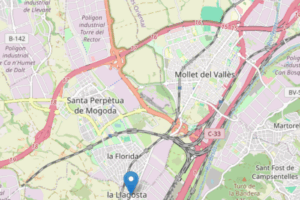
iPROPEZESPADA: Innovation in Swordfish Fishing through AI-Based Biometric Measures
July 10, 2025
VALORFIN: New Cementitious Materials from the Valorisation of the Fine Fraction of Construction and Demolition Waste
July 22, 202514/07/2025
A team led by the Electronic and Biomedical Instrumentation (IEB) research group at the Universitat Politècnica de Catalunya – BarcelonaTech (UPC) is developing an electronic chip designed to bring greater objectivity to the detection of potential infractions in race walking, which are currently judged solely through visual observation. This technology, already trialled in official competitions, provides more accurate, objective, and fair data on instances where athletes lose ground contact.
Race walking is a discipline based on walking, governed by specific rules that distinguish it from running. According to these rules, athletes must maintain continuous visual contact with the ground, and the leading leg must remain straight from first contact until it is vertically aligned under the body. However, it has been shown that human perception is not sufficiently accurate to detect certain losses of contact, which can lead to disputes and erroneous disqualifications by judges during competitions.
In this context, the Race Walking Electronic Control System (RWECS) offers a technological solution that is both objective and precise for detecting infractions in race walking—a sport where judges must currently determine whether athletes maintain constant ground contact using only visual cues, as required by current regulations. The system is based on electronic devices attached to shoelaces, weighing less than 15 grams and about the size of a one-euro coin, making them minimally intrusive for race walkers. This new device (dubbed the “VAR for race walking”) offers an objective, reliable, and fair solution, as it can record every step and detect losses of contact with the ground at a resolution of 0.002 seconds—yielding a margin of error smaller than that of human observation.
As part of the project, a network infrastructure has been designed, configured, and deployed to track the devices using Bluetooth and WiFi technologies. Additionally, video processing tools have been developed to monitor compliance with the other key rule of the sport, which requires the front leg to remain straight from heel strike to the vertical position. This aspect is also currently judged subjectively, posing an additional challenge for implementing technological means to ensure objective enforcement.
Putting the ‘VAR’ to the test
The system has already been tested in an official competition of the Royal Spanish Athletics Federation (RFEA) in Tarragona and in an event held by the Catalan Athletics Federation in Barcelona. As a final project test, the system was validated during the Gran Premio Internacional Madrid Marcha Silbö Telecom, a Gold category event of the World Race Walking Tour, which took place on Sunday, 1 June, on Madrid’s Gran Vía.
The development of RWECS marks the culmination of over a decade of research by the participating team, part of UPC’s Department of Electronic Engineering. This latest trial was made possible thanks to students from the Bachelor’s Degree in Telecommunication Technologies and Services Engineering (GRETST) at ETSETB, who tested the RWECS as part of the Advanced Engineering Project (PAE) subject.


Sector
Topic
You want to know more?
Related Projects
- The Centre of Technological Innovation in Power Electronics and Drives (CITCEA) of the Universitat Politècnica de Catalunya - BarcelonaTech (UPC) is leading a European project that redesigns the current energy system to stabilise the power grid in the face of high renewable energy penetration. The proposed solutions involve using the loads that consume energy to help balance the grid.
- A team from the Environment Centre Laboratory (LCMA) of the Universitat Politècnica de Catalunya - BarcelonaTech (UPC) is taking part in a study commissioned by the city councils of la Llagosta, Mollet and Santa Perpètua (in Vallès Occidental), with the main objective of identifying the impact of industrial plants on the generation of unpleasant odours and continuously monitoring air quality in these municipalities.
- Researchers from the Concrete Sustainability and Smart Structures (C3S) research group, part of the Construction Engineering (EC) group at the Universitat Politècnica de Catalunya - BarcelonaTech (UPC), are leading the CIRC-BOOST project, which aims to promote sustainability, industrial competitiveness and greater resource efficiency in the European construction sector.
- A research team involving the Barcelona Innovative Transportation (BIT), inLab FIB, CARNET Barcelona – Future Mobility Research Hub (CER-AMA), and the Department of Computer Architecture (DAC) of the Universitat Politècnica de Catalunya - BarcelonaTech (UPC) is driving the i-MovE project, which aims to incorporate multisectoral data to provide much more accurate and valuable information for the mobility sector. The project develops four use cases focused on both companies and mobility authorities, covering public and individual transport, using the UPCxels demonstrator.




